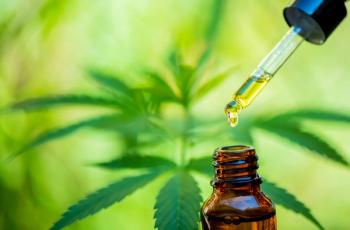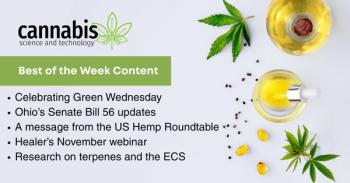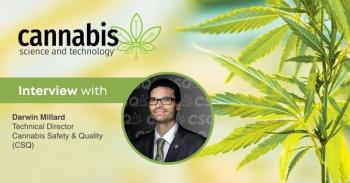
Nonpsychoactive Cannabinoids: Science, Safety, and Therapeutic Potential
Key Takeaways
- Nonpsychoactive cannabinoids interact with the ECS, influencing pain, inflammation, mood, and more, offering therapeutic potential without intoxicating effects.
- Compounds like CBDA, CBG, and CBN show promise in pain relief, sleep support, and cognitive enhancement, with ongoing research exploring their mechanisms.
Our sister publication, Nutritional Outlook, covered the science, safety, regulatory challenges, and therapeutic potential of nonpsychoactive cannabinoids including CBN, CBG, and CBDA.
Originally published as "
What are Nonpsychoactive Cannabinoids?
Though different from the psychoactive cannabinoid tetrahydrocannabinol (THC), which produces intoxicating effects, nonpsychoactive cannabinoids do operate through the endocannabinoid system (ECS). This regulatory network controls many bodily functions through CB1 and CB2 receptors located throughout the brain and body (1). The cannabinoids stimulate the receptors and modulate the systems. “The ECS is one of the body’s most powerful regulatory systems, influencing pain, inflammation, mood, metabolism, immune function, and reproduction,” explains Caitlyn Krebs, CEO of Nalu Bio (San Francisco, CA), creator of a proprietary AI-powered ECS drug discovery platform. “Yet, the ECS has been historically overlooked due to the stigma surrounding cannabinoids. That’s changing. Advances are finally unlocking the ECS’s vast potential—opening the door to a new class of reliable, non-addictive health solutions.”
Some of the more commonly used and researched nonpsychoactive cannabinoids include cannabidiolic acid (CBDA), cannabigerol (CBG), cannabinol (CBN), tetrahydrocannabivarin (THCV), and cannabichromene (CBC).
Functional and Therapeutic Potential
Nonpsychoactive cannabinoids have been demonstrated to provide functional benefits through multiple mechanisms of action.
For example, CBDA is a notable compound, explains osteopathic physician Dustin Sulak, founder of Healer.com, a cannabis education and product resource. “CBDA, the precursor of CBD, is similar to its more well-known counterpart but is much stronger (10 to 1000 times stronger based on animal models of pain, seizures, and nausea), and much better absorbed into the body,” he explains.Similarly, CBG can be an option for pain, sleep disturbances, and anxiety, based on a soon-to-be published study, Dr. Sulak adds. “Even though it can address many of the same symptoms as CBDA, it does so via different pathways in the body—this means it’s a great option for people who haven’t responded fully to CBDA, as an add-on or an alternative,” he explains.
CBN has demonstrated support for sleep and cognition, explains Alleh Lindquist, director and CEO of FloraWorks (Milwaukie, OR), noting that the biotechnology company was founded to expand on the potential of this cannabinoid. A 2023 study found reductions in sleep disturbance scores after supplementation from TruCBN from FloraWorks, with improvements in sleep quality the same as or better than results seen with melatonin (2). Additionally, a recent in vivo study examined TruCBN on age-related cognitive decline through mitochondrial modulation (3), finding improvements in cognitive function, restoration of synaptic function markers, enhancement of mitochondrial dynamics, and regulation of metabolism, as well as evidence that the modular effects of CBN are potentially gender dependent.
THCV also shows potential for therapeutic effects, Lindquist states, noting that the research and adoption is still in the early stages. “It’s a cannabinoid with real potential in performance and wellness products, and down the road, in metabolic health therapeutics.” The cannabinoid blocks CB1 receptors at low doses, potentially reducing appetite, supporting focus and energy, he explains. “Cannabinoids like CBN and THCV highlight the dual opportunity in this space: they’re functional ingredients with immediate consumer relevance and valuable starting points for cannabinoid drug discovery,” he adds.
CBC shows potential for another top wellness challenge, Krebs explains. “It engages CB2 receptors and TRP channels to regulate immune response and inflammation, showing potential for joint health and mobility,” she states.
Cannabinoids in Functional Foods and Beverages
While beverages containing THC are growing as an alternative to alcohol, Lindquist explains, functional beverages with other cannabinoids such as CBN or THCV are still in the early stages of research, though there is potential for CBN for “evening and recovery drinks” while THCV could be beneficial in the energy and performance areas. “So, while the academic research on beverages is still light, the market momentum is clear,” he explains. “Functional drinks are already becoming a go-to format, and as more data comes out on cannabinoids, they’ll play a much bigger role in helping tune healthy physiological functions through everyday products.”
The potential formats for nonpsychoactive cannabinoids are significant. “Emulsions improve dispersion and dose uniformity; however, acidic beverages can slowly convert CBD to THC over time, so pH and shelf-life validation are critical,” Krebs notes. With its AI-driven platform, Nalu Bio created the wellness line called meld, delivering combinations of chemistry-derived non-intoxicating cannabinoids and vitamins for various health benefits. “For meld, we have opted for an initial gummy format, as each unit is a pre-measured dose, which improves day-to-day consistency. Plus, gummies also have a high consumer adherence compared with tinctures or beverages.”
Consumption alongside other foods is also something to note, Krebs adds, stating that consuming the cannabinoids with fatty foods affects absorption, and dosing instructions should reflect this.
Synergies Stacked
There is potential for pairing cannabinoids with conventional supplements, however, because the use of cannabinoids is still relatively new, more research is still needed to understand how cannabinoids can be paired with other functional dietary ingredients. Krebs explains that non-intoxicating cannabinoids have been shown to act through complementary biological pathways as other supplements. “For example, melddelivers potent pairings of non-intoxicating cannabinoids and essential vitamins, including D3, B6, E, and B12 to support stress, weight management, mobility, and sleep,” she notes.
Hypothetically, supplement stacking presents more opportunities for manufacturers. Lindquist sees great potential in these combinations and synergy. “For example, if you take a cannabinoid that shows neuroprotective effects by helping protect mitochondria from oxidative damage, pairing it with something like NAD+, which is known for boosting mitochondrial energy, could be really interesting,” he explains. “Add omega-3 fatty acids into the mix for their well-documented brain health benefits, and you start to see the outline of a powerful brain health and longevity stack.”
“The broad influence of the microbiome and the endocannabinoid system, which are enhanced by probiotics and omega-3 fatty acids, respectively, likely do impact the function of cannabinoids like CBDA and CBG in some ways yet to be discovered,” Dr. Sulak stated.
Consumer Demographics
Cannabinoids could play a role in a demand for more personalized or gender specific support for conditions. Older adults, women, and consumers with chronic conditions or nervous system disorders in particular seem to stand from the potential benefits from nonpsychoactive cannabinoids.
“The group turning to cannabinoids the fastest right now is older adults, and the two main reasons are sleep and pain,” states Lindquist.
Dr. Sulak notes that the Respite gummy from Healer contains CBG in the nighttime formula and is intended for consumers with dementia symptoms including agitation and sleep disturbances.
“People with nervous system disorders may be more likely to benefit from CBDA and CBG because in addition to the symptom relief they provide, they have also been shown to have protective and healing effects in the brain and peripheral nerves,” Dr. Sulak adds.
Krebs notes that only 1% of supplements are designed for women, making it a profoundly underserved population. “Research shows women often have a higher density of CB1 receptors, metabolize ECS-targeted compounds more slowly—extending their effects—and experience hormonal fluctuations closely tied to ECS signaling,” explains Krebs. “These biological differences create unique opportunities for ECS-based interventions across life stages.”
Science and Safety
Though more research is needed for confirmation, nonpsychoactive cannabinoids, even at higher doses, have not shown health concerns in animal and human studies, Lindquist states. No toxicity has been reported for CBG or CBDA, Dr. Sulak adds.
Manufacturing standards are a bigger concern with cannabinoids, Linquist states. He expects standards to improve as the industry matures, but currently GMP standards and ISO certification are not yet commonplace, which risks exposure to contaminants such as pesticides and solvents in products, or fabricated Certificates of Analysis (COAs).
FloraWorks, which operates under and maintains GMP and ISO certification, has conducted the toxicology studies for its CBN required for FDA dietary ingredient approval and has not found health concerns.
In addition to being manufactured under GMP standards, Nalu Bio’s meld is supported by third-party in-vitro, animal, and human clinical data for its nonintoxicating cannabinoids at typical supplement doses, Krebs notes.
Regulation and Research Roadblocks
Cannabinoids face regulatory challenges to their widespread use. While cannabis is still listed as a Schedule I drug according to the Controlled Substances Act, hemp, defined as cannabis with a delta-9 THC concentration no more than 0.3% of THC on a dry weight basis, was removed from this list with the passing of the 2018 Farm Bill (4). The production and research of hemp-derived cannabinoids, especially CBD, subsequently grew. However, the products are not allowed to be labelled as supplements, according to the FDA (5) and in January 2023, the FDA released a statement explaining that current regulatory frameworks for food and supplements are not appropriate for CBD (6).
The Council for Responsible Nutrition (CRN) has continuously advocated for action from the FDA on CBD policy. In July 2023 for example, CRN requested Congress to “demand FDA complete the work Congress directed the agency to do under the 2018 Farm Bill by permitting CBD and other hemp-derived cannabinoids to be lawfully marketed as dietary supplements using the appropriate safeguards found in the existing law” (7).
However, as Linquist notes, there is still no consistent national standard for hemp products. “At the federal level, the only clear framework today is the drug pathway, the same one CBD followed when it was approved for epilepsy,” he explains, referencing the 2018 approval by the FDA of purified pharmaceutical-grade cannabidiol (CBD) medication, Epidiolex for the treatment of the seizure disorder Dravet syndrome (8). “At FloraWorks, we’ve taken the step of conducting all the standard safety studies the FDA requires to file a New Dietary Ingredient (NDI) application for our CBN. This is the first time it’s been done for a non-intoxicating cannabinoid. We see this as a way to help bring clarity to the dietary ingredient path so cannabinoids can move into the mainstream with the same regulatory confidence as other ingredients.”
The stigma surrounding cannabis is still a challenge to support additional science on their therapeutical potential and constructive regulatory frameworks of cannabinoids, he adds, which could block access to consumers.
Some international standards exist, Krebs notes, which help provide clearer dosing guidelines. In October 2023, the UK Food Standards Agency (FSA) updated its recommendation on daily CBD limits for healthy adults (down to 10 mg from 70 mg per day), based on industry evidence and advice from FSA’s scientific committees (9). Krebs agrees that the regulatory landscape surrounding nonintoxicating cannabinoids must evolve, allowing for large, multi-site nutrition trials.
Looking Down the Road
Perhaps not surprisingly, the future of non-psychoactive cannabinoids depends on more research and data. Krebs lists three main priorities for understanding the therapeutic value: dose-related studies to define effective ranges for a variety of conditions, long-term safety data to assess drug interactions and impacts on health, and sex-specific research due to women’s hormone-related interactions with the ECS.
More research is needed on the mechanisms of action and safety, which would support consumer confidence, Lindquist states. “AI can help connect the dots, but only if it’s backed by robust lab data,” he explains. “From there, we can start to truly understand their therapeutic potential and how to use them responsibly.”
Based on current research and testimony, nonpsychoactive present unique opportunities in the dietary supplement space. Though a lack of suportive regulations provide challenges to their use, evolving consumer trends open the door for these compounds to fulfill their personalized needs in new ways.
References
- Grinspoon, P. The endocannabinoid system: Essential and mysterious. Harvard Health Publishing. August 11, 2021.
https://www.health.harvard.edu/blog/the-endocannabinoid-system-essential-and-mysterious-202108112569 (Accessed 2025-09-29) - Krawiec, S. FloraWorks announced results of study demonstrating sleep benefits of its flagship CBN ingredient. Nutritional Outlook. August 23, 2023.
https://www.nutritionaloutlook.com/view/floraworks-announced-results-of-study-demonstrating-sleep-benefits-of-its-flagship-cbn-ingredient (Accessed 2025-09-29) - McEvoy, E. New animal research highlights the potential for cannabinol to support cognition in aging brains. Nutritional Outlook. July 17, 2025.
https://www.nutritionaloutlook.com/view/new-animal-research-highlights-the-potential-for-cannabinol-to-support-cognition-in-aging-brains (Accessed 2025-09-29) - McEvoy, E. In the weeds: An update on the hemp regulatory landscape. Nutritional Outlook. 2024, 27 (8).
- Anzarut, K.Update from the FDA: Not Adopting Existing Regulations for the CBD Industry. Cannabis Science and Technology. March 1, 2023.
https://www.cannabissciencetech.com/view/update-from-the-fda-not-adopting-existing-regulations-for-the-cbd-industry (Accessed 2025-09-29) - U.S. Food and Drug Administration. Woodcock, J. FDA Concludes that Existing Regulatory Frameworks for Foods and Supplements are Not Appropriate for Cannabidiol, Will Work with Congress on a New Way Forward. January 26, 2023.
https://www.fda.gov/news-events/press-announcements/fda-concludes-existing-regulatory-frameworks-foods-and-supplements-are-not-appropriate-cannabidiol (Accessed 2025-09-29) - Council for Responsible Nutrition. CRN Asks Congress to Demand FDA ‘Complete the Work’ to Allow CBD to be Marketed as a Dietary Supplement. July 27, 2023.
https://www.crnusa.org/newsroom/crn-asks-congress-demand-fda-complete-work-allow-cbd-be-marketed-dietary-supplement (Accessed 2025-09-29) - Abu-Sawwa, R.; Stehling C. Epidiolex (Cannabidiol) Primer: Frequently Asked Questions for Patients and Caregivers. J Pediatr Pharmacol Ther. 2020, 25(1):75-77. DOI:
10.5863/1551-6776-25.1.75 . - Government Chemist. UK Government responds to expert advice on CBD. November 3, 2023.
https://www.gov.uk/government/news/uk-government-responds-to-expert-advice-on-cbd
Newsletter
Unlock the latest breakthroughs in cannabis science—subscribe now to get expert insights, research, and industry updates delivered to your inbox.





